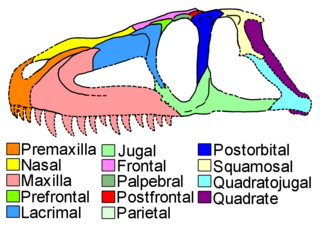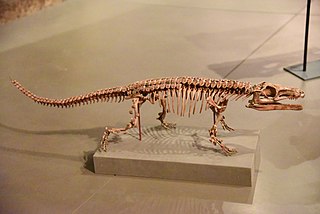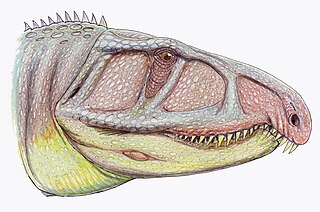
Garjainia is an extinct genus of erythrosuchid archosauriform reptile from the Olenekian of Russia and South Africa. It was approximately 1.5–2 metres (4.9–6.6 ft) long. It contained two species, Garjainia prima from the Yarengian/Yarkenskian Supergorizont of Russia, and Garjainia madiba from the Burgersdorp Formation of South Africa. "Vjuskovia triplicostata", a name assigned to some erythrosuchid fossils from Russia, has been synonymized with Garjainia prima.

Batrachotomus is a genus of prehistoric archosaur. Fossils of this animal have been found in southern Germany and dated from the Ladinian stage of the Middle Triassic period, around 242 to 237 million years ago. Batrachotomus was described by palaeontologist David J. Gower 22 years after its discovery.

Luperosuchus is an extinct genus of loricatan pseudosuchian reptile which contains only a single species, Luperosuchus fractus. It is known from the Chañares Formation of Argentina, within strata belonging to the latest Ladinian stage of the late Middle Triassic, or the earliest Carnian of the Late Triassic. Luperosuchus was one of the largest carnivores of the Chañares Formation, although its remains are fragmentary and primarily represented by a skull with similarities to Prestosuchus and Saurosuchus.

Archosaurus is an extinct genus of carnivorous proterosuchid archosauriform reptile. Its fossils are dated to the latest Permian of Russia and Poland, it is one of the earliest known archosauriforms. The type and only species is Archosaurus rossicus, known from several fragmentary specimens which cumulatively represent parts of the skull and cervical vertebrae. It would have been 3 metres (9.8 ft) long when fully grown.
Dongusuchus is an extinct genus of archosaur. Fossils have been found from the Donguz Formation outcropping on the banks of the Donguz River in the Orenburg Oblast of Russia. They are associated with a fossil assemblage called the Eryosuchus Fauna, named after the capitosaurid Eryosuchus, the most common organism found from the assemblage. The locality dates back to the Anisian and early Ladinian stages of the Middle Triassic.
Energosuchus is an extinct genus of rauisuchian. Fossils are present from the upper Karyomayol and lower Synya Formations outcropping along the banks of the Bolshaya Synya river in the Timan-North Urals region in northern European Russia, as well as from the Bukobay Formation in the southern part of Bashkortostan in the southern Urals of European Russia. Both localities date back to the Ladinian stage of the Middle Triassic.

Mandasuchus is an extinct genus of loricatan pseudosuchian from the Manda Formation of Tanzania, which dates back to the Anisian stage of the Middle Triassic. Although this genus was first mentioned by Alan Charig in 1956, a formal description was not published until 2018.

Parringtonia is an extinct genus of Triassic archosaur within the family Erpetosuchidae, known from the type species Parringtonia gracilis. It is known from a single specimen, NHMUK R8646, found from the Anisian-age Manda Formation of Tanzania. This specimen, like most archosaur material from the Manda Formation, is fragmentary, including only a maxilla and a few postcranial bones. They show similarities with those of another archosaur called Erpetosuchus, known from the Middle Triassic of Scotland and the eastern United States. The phylogenetic placement of Parringtonia and Erpetosuchus are uncertain; some studies placed them close to the group Crocodylomorpha, which includes all modern crocodylians and many extinct forms that diversified after the Triassic, but this relationship has more recently been questioned.
Tsylmosuchus is an extinct genus of proterosuchid archosauriform reptile known from Western Russia. Fossils referred to Tsylmosuchus occurred over a wide area in sediments corresponding to the Induan and Olenekian stages of the Early Triassic. Most of these fossils are fragmentary neck vertebrae which were originally reported as sharing similarities with crocodile-line archosaurs (pseudosuchians) such as Mandasuchus. As a result, Tsylmosuchus was first described as part of the family Rauisuchidae, making it supposedly one of the oldest known archosaurs. However, its fragmentary remains do not show any of the distinguishing features of rauisuchids or even pseudosuchians in general, so Tsylmosuchus has more recently been interpreted as an indeterminate archosauriform. Although three species of Tsylmosuchus have been named, they lack diagnostic traits and are probably not distinct from each other. In 2023, Tsylmosuchus was reinterpreted as a proterosuchid, specifically a member of the subfamily Chasmatosuchinae.
Vjushkovisaurus is an extinct genus of Middle Triassic archosauriform. It is known from the Anisian-aged Donguz Gorizont in Sol-Iletsk, Orenburg Oblast, Russia. The genus was named in 1982, with the type species being V. berdjanensis. Material has been collected in the Berdyanka II locality from a fossil assemblage called the Eryosuchus Fauna along the Berdyanka River, specifically in a sand-carbonate concretion in the upper part of the main river channel. Vjushkovisaurus is known only from the holotype PIN 2865/62, a partial postcranial skeleton which consists of 12 presacral vertebrae, left humerus, ribs, a fragment of the coracoid and a fragment of the fibula.
Vytshegdosuchus is an extinct genus of paracrocodylomorph archosaur known from the Early Triassic Yarenskian Gorizont of the Komi Republic of the European section of Russia. It contains a single species, Vytshegdosuchus zheshartensis. Vytshegdosuchus was named by Andreii Sennikov in 1988.

Youngosuchus is an extinct genus of archosaur from the Middle Triassic of China. The type species is Y. sinensis. Y. sinensis was first described in 1973 as a new species of the erythrosuchid Vjushkovia. In 1985, it was reassigned as its own genus of rauisuchid. A 1992 study supported the original classification of Youngosuchus sinensis as an erythrosuchid, but more recent studies classify it as a "rauisuchian"-grade loricatan archosaur completely unrelated to Vjushkovia, which is most likely a synonym of Garjainia.
Xilousuchus is an extinct genus of poposauroid from lower Triassic deposits of Fugu County of northeastern Shanxi Province, China. It is known from the holotype, IVPP V 6026, a single well-preserved partial skeleton including the skull. It was found from the Heshanggou Formation of the Ordos Basin, Hazhen commune. It was first named by Xiao-Chun Wu in 1981 and the type species is Xilousuchus sapingensis. Wu (1981) referred Xilousuchus to the Proterosuchia. Gower and Sennikov (1996) found it to be an erythrosuchian based strictly on the braincase. A more detailed re-description of the genus was provided by Nesbitt et al. (2010) and found poposauroid affinities. In his massive revision of archosaurs which included a large cladistic analysis, Sterling J. Nesbitt (2011) found Xilousuchus to be a poposauroid which is most closely related to Arizonasaurus. Xilousuchus is the oldest archosaur to date, although Ctenosauriscus and Vytshegdosuchus might be even older by less than one million year. Since Xilousuchus is a suchian archosaur, its early age suggests that most of the major groups of archosaurs developed by the Early Triassic, soon after the appearance of the first archosaur.
Vonhuenia is an extinct genus of proterosuchid, a basal archosauriform from the Early Triassic of Russia. Fossils have been found in the Vokhminskaya Formation, along the Vetluga River that are Induan in age, making Vonhuenia one of the earliest archosauriforms.

Erpetosuchidae is an extinct family of pseudosuchian archosaurs. Erpetosuchidae was named by D. M. S. Watson in 1917 to include Erpetosuchus. It includes the type species Erpetosuchus granti from the Late Triassic of Scotland, Erpetosuchus sp. from the Late Triassic of eastern United States and Parringtonia gracilis from the middle Middle Triassic of Tanzania; the group might also include Dyoplax arenaceus from the Late Triassic of Germany, Archeopelta arborensis and Pagosvenator candelariensis from Brazil and Tarjadia ruthae from Argentina.

Wangisuchus is an extinct genus of archosauriform reptile from the Middle Triassic of China that is known from fragmentary fossil jaw bones. These bones were found at the Hsishihwa locality in the upper Ermaying Formation, which dates to the late Anisian stage about 242 million years ago. Wangisuchus was named in 1964 by Chinese paleontologist Yang Zhongjian, who described a single species, Wangisuchus tzeyii, on the basis of these bones.

Uralosaurus is an extinct genus of erythrosuchid archosauriform known from the Middle Triassic Donguz Formation of southeastern European Russia. It contains a single species, Uralosaurus magnus. It was named by Vitalii Georgievich Ochev in 1980 as a species of Erythrosuchus otherwise known from the Triassic of Africa and reassigned to its own genus by Andrey G. Sennikov in 1995.

Asperoris is an extinct genus of archosauriform reptile known from the Middle Triassic Manda Beds of southwestern Tanzania. It is the first archosauriform known from the Manda Beds that is not an archosaur. However, its relationships with other non-archosaurian archosauriforms are uncertain. It was first named by Sterling J. Nesbitt, Richard J. Butler and David J. Gower in 2013 and the type species is Asperoris mnyama. Asperoris means "rough face" in Latin, referring to the distinctive rough texture of its skull bones.

Vivaron is a genus of rauisuchid known from the Late Triassic Chinle Formation in New Mexico. It is the second rauisuchid known from the southwestern United States, and it highlights the wide biogeographic range similar rauisuchid taxa occupied during the Late Triassic across Pangaea, despite the varied faunal assemblages at different latitudes.

Polymorphodon is an extinct genus of archosauriform reptile from the Middle Triassic of Germany. The only known species is Polymorphodon adorfi, discovered in Lower Keuper deposits at a quarry in Eschenau, Germany. Polymorphodon is notable for its heterodont dentition, with long and conical premaxillary teeth followed by thin maxillary teeth with large serrations. Maxillary teeth near the back of the mouth are short and leaf-shaped, similar to some living and extinct reptiles with a herbivorous or omnivorous diet. This may suggest that Polymorphodon had some reliance on plants in its diet, a rarity among basal archosauriforms, most of which are carnivores.













